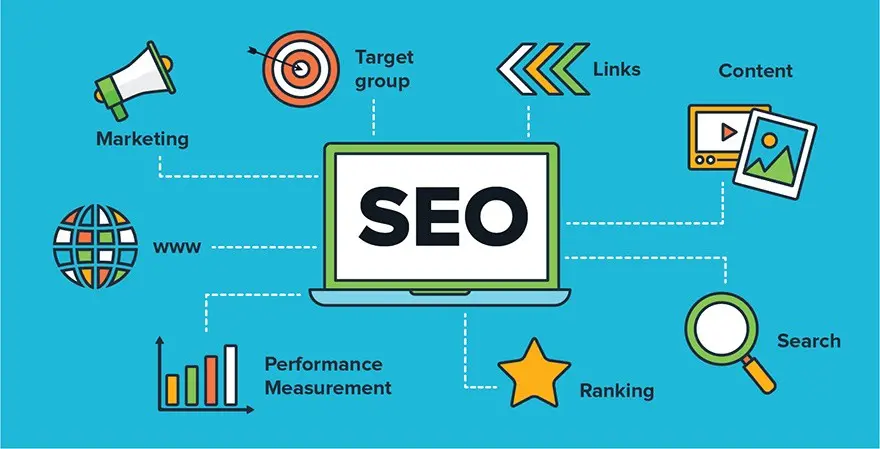What is SEO? Basics and Benefits for Success
SEO, Search Engine Optimization, is all of the strategic work done to make your website rank higher in search engines such as Google and Bing. So, why is this important? Because the vast majority of users usually click on the first page of results when searching for something on search engines. For example, when you search for “mobile application development” on Google, do you go to the second or third page? Mostly not! Here SEO aims to move your site to that first page, even to the first ranks if possible.
The main goal is to make the content of your site suitable for the algorithms of search engines, so that users can access the information they are looking for in the fastest and most accurate way. This process covers a wide range of topics from technical adjustments to content optimization, from user experience to backlink strategies.

Key Elements of Website Optimization
Search engine visibility is built on three main pillars:
Technical Foundations: Optimizing the infrastructure of your website. For example, site speed, mobile compatibility and URL structure.
Content Strategy: Producing quality, user-oriented and keyword-appropriate content.
External Signals: External factors such as backlinks and social signals to increase the authority of your website.
Why Optimization is Important?
In the digital age, the visibility of a website directly affects the success of your business. Here are a few critical points on why search performance matters:
1. Organic Traffic Growth
A well-optimized site allows you to attract more visitors for free and naturally. Ranking high on Google makes it more likely that your target audience will find you. For example, if you run a patisserie and you are at the top of the “patisseries near me” search, more customers will knock on your door.
2. Credibility and Authority
Users trust sites that appear at the top of search results. A solid visibility strategy strengthens your brand’s authority and builds a reliable image in users’ minds.
3. Cost Effectiveness
Compared to paid methods such as PPC (pay-per-click) ads, organic growth is a long-term and sustainable investment. Once optimized, a page can generate traffic for years.
4. User Experience
Efforts to enhance search performance also improve overall user experience. Fast-loading pages, mobile compatibility and easy navigation encourage visitors to stay longer on your site.
How to Improve Visibility? Basic Strategies
Being discoverable online is not a one-time fix; it requires patience, planning and continuous improvements. Here are key strategies for boosting your presence:
1. Keyword Research
The right keywords are at the heart of every successful content effort. Research helps you understand what your audience is searching for. For example, if you are a fitness coach, identifying terms like “home workout programs” helps tailor your content effectively.
Tip: Tools like Google Keyword Planner, Ahrefs or SEMrush are great for analyzing keyword volume and competition.
2. Quality Content Production
Content is still king. Creating informative and engaging material that answers user questions boosts your rankings. For example, if you’re writing a blog, make sure your content is clear, structured and aligns with your target phrases.
What to Pay Attention to?
Use keywords naturally in headings and subheadings.
Break the content into short paragraphs and support it with images.
Update your content regularly.
3. Technical Improvements
The structure of your website directly affects how well it performs in search engines. Important steps for better crawling and indexing include:
Site Speed: Slow loading sites drive users away. Check your site speed with Google PageSpeed Insights.
Mobile Compatibility: Google prioritizes mobile-friendly sites. Use responsive design.
SSL Certificate: Use HTTPS for a secure site.
Sitemap: Helps search engines understand your site better.
4. Backlink Strategy
Backlinks—links from other sites to yours—boost your authority and relevance. But quality is more important than quantity. Links from reputable sources positively influence your ranking.
How to Get Backlinks?
Write guest blog posts.
Collaborate with respected sites in your industry.
Gain natural links by producing valuable content.
5. Follow Google Trends
By following Google Trends, you can analyze your keywords or discover popular terms relevant to your niche. Plan your content strategy based on what users search for over specific time periods.

What are the Advantages of SEO?
The benefits of SEO are not limited to ranking increases. Here are the values that SEO will add to your business:
1. Long Term Success
SEO, once done right, continues to deliver results for years. For example, a well-optimized blog post can consistently drive organic traffic.
2. Targeted Traffic
SEO allows you to reach your target audience with the right keywords. This increases your conversion rates because visitors to your site are already interested in your product or service.
3. Competitive Advantage
If your competitors are investing in SEO, you shouldn’t lag behind. Ranking in the top positions allows you to stay one step ahead in your industry.
4. Measurable Results
The beauty of SEO is that its results are measurable. With tools like Google Analytics and Search Console, you can easily track your traffic, rankings and user behavior.
5. User Acquisition
If you rank high in search engines with successful SEO efforts, you will be more likely to gain new users.
Common Mistakes in SEO
You have learned what you need to do for success in SEO, so what should you avoid? Here are common mistakes:
Keyword Stuffing: Overusing keywords unnecessarily can make your content look spammy.
Poor Quality Content: Content that is not user-oriented, direct quotes from AI, duplicate or low-quality content will lower your ranking.
Technical Errors: Broken links, slow loading times or indexing issues undermine your SEO performance.
Backlink Spam: Backlinks from low quality sites can damage your site.
- Excessive Backlink Usage: The excessive backlinks you will use in your articles can bring users to the links you give rather than you.
- Don’t break SEO rules: If you don’t follow or break stereotypes, search engines will lower your rankings.
In conclusion, SEO is one of the keys to success in the digital world. With the right strategies, you can move your website to the top of search engines, get organic traffic and increase the authority of your brand. Now you know the answer to the question of what SEO is: It is not only a technical process, but also a user-oriented art. From keyword research to quality content production, from technical optimization to backlink strategies, every step is a building block on the road to success.



Pingback: How to Build a Website? 2025 Updated Step-by-Step Guide - Codinic
Pingback: Digital Marketing: Best Strategies for Brands - Codinic
Pingback: What is SEO Agency? The Importance of SEO for Businesses - Codinic